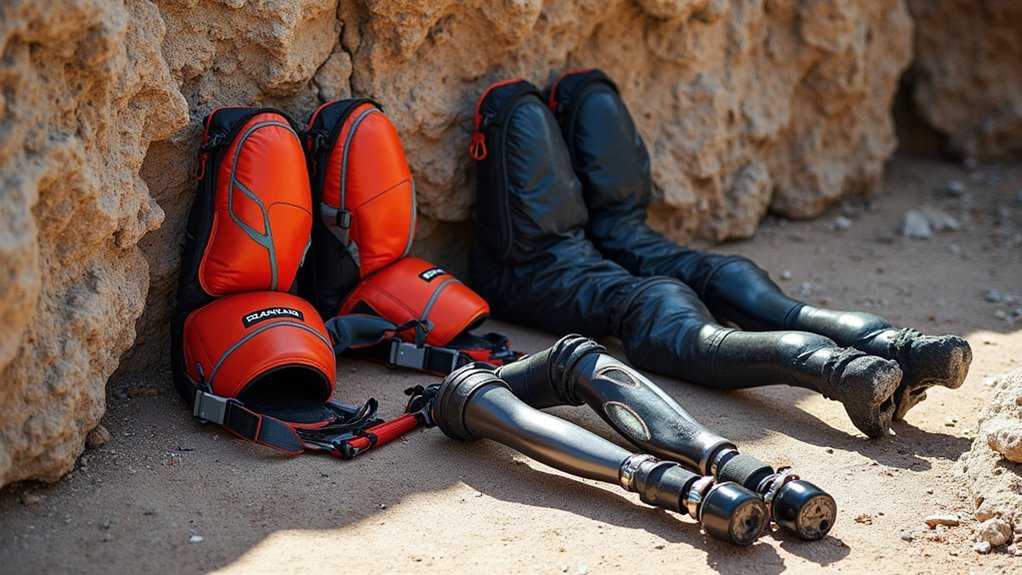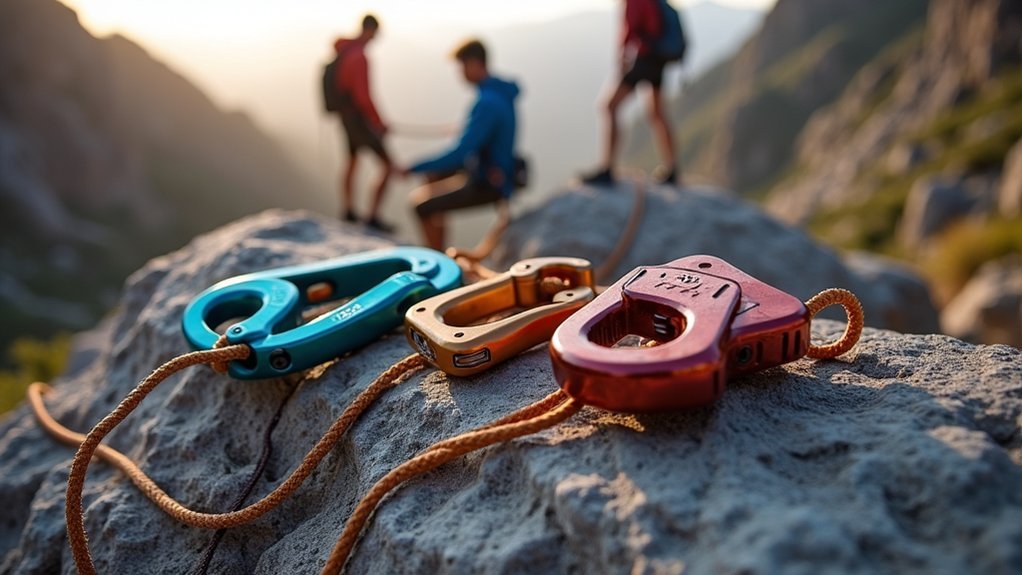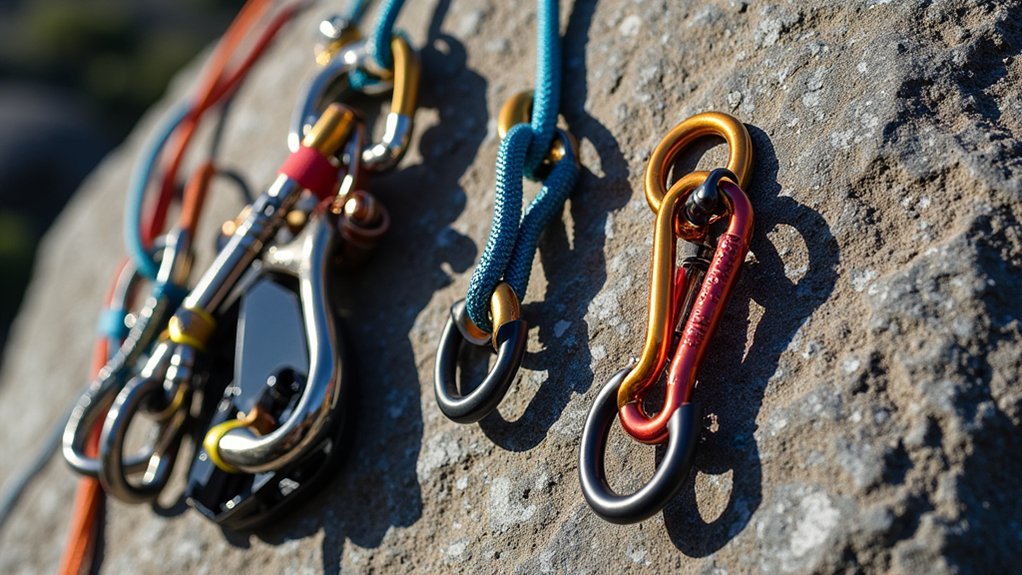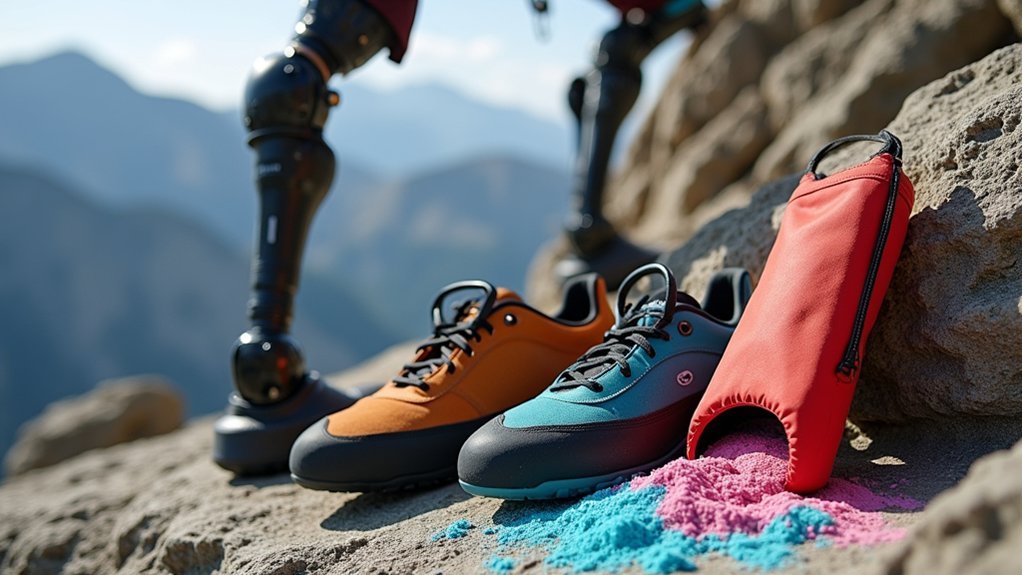Essential adaptive climbing gear for amputees includes specialized climbing harnesses with extra padding to prevent pressure sores, customized prosthetic limbs like the ADK climbing foot for better performance, adaptive belay devices that reduce physical strain, climbing shoes designed to accommodate prosthetics, and safety attachment systems for securing prosthetics to harnesses. These innovations allow you to climb safely while minimizing skin damage and maximizing efficiency. Discover how these specialized tools can transform your vertical adventures.
Specialized Climbing Harnesses and Padding Systems

While traditional climbing gear presents challenges for amputees, specialized harnesses have revolutionized accessibility in the sport. The Wellman Chest Harness provides upright positioning with adjustable features that guarantee security during adaptive climbing sessions.
Specialized harnesses with adaptive features have transformed climbing from an exclusive pursuit to an accessible adventure for all body types.
You’ll find sit harnesses particularly beneficial if you have paraplegia or incomplete quadriplegia, as they’re designed to optimize weight distribution and support respiration. These can be combined with chest harnesses for enhanced stability when you have limited leg function.
Look for adaptive leg loops with wider straps and extra padding to prevent pressure sores during climbs. These protective features are vital when you’re using a climbing shoe on your residual limb.
Proper padding systems aren’t just about comfort—they’re important for preventing skin damage during extended climbing sessions, allowing you to focus on the ascent rather than discomfort.
Prosthetic Limbs Designed for Vertical Challenges
Since traditional prosthetics aren’t tailored for the unique demands of climbing, specialized adaptive limbs have emerged to transform the sport for amputees. Products like the ADK climbing foot provide essential flexibility and spring, enhancing your performance during ascents.
For adaptive climbers, customized prosthetic sockets guarantee proper fit and support, reducing injury risk while maintaining stability on the wall. The lightweight SCALO prosthetic climbing arm offers malleable properties that improve your ability to grip holds efficiently.
Modern climbing prosthetics often mimic natural foot movements, allowing you to engage in high-stepping maneuvers and better utilize footholds.
You’ll need to maintain your equipment regularly to guarantee peak functionality and prevent skin issues. With proper adaptation and care, these specialized limbs can greatly improve your climbing experience.
Adaptive Belay Devices and Rope Management Tools

Adaptive belay devices and rope management systems represent vital innovations that allow amputee climbers to navigate vertical terrain safely and independently.
When selecting equipment for your climbing journey, you’ll find that many adaptive belay devices like the Pro Traxion create secure systems while reducing physical strain during ascents.
Climbers prefer incorporating specialized rope management tools for enhanced performance:
- Power-belay systems provide important support for those with mobility limitations, making your climbing experience smoother and safer
- The Wellman Pull Up Bar allows you to raise yourself higher with minimal effort, promoting independence on the wall
- Creating a 2:1 rope system greatly improves efficiency for climbers using adaptive equipment
Remember to regularly check and maintain your adaptive devices to guarantee functionality and safety during each climbing adventure.
Customized Climbing Shoes and Foot Solutions
Climbers with limb differences face unique challenges that standard gear simply can’t address. When seeking customized climbing shoes, you’ll benefit from designs specifically tailored to accommodate prosthetic limbs while maintaining the snug fit essential for technical climbing.
The ADK climbing foot by Mountain Orthotic and Prosthetic Services has gained popularity among amputee climbers for preventing finger injuries and helping climbers advance through grades.
Similarly, Evolv’s Adaptive Foot, developed with input from experienced paraclimbers, delivers performance-enhancing features through its innovative design.
Look for shoes with specialized fastening systems that provide flexibility across various climbing environments.
Remember that properly securing your prosthetic limbs to your harness is critical for safety. These adaptations don’t just enable climbing—they empower you to climb with confidence and control.
Safety Attachment Systems for Securing Prosthetics

When ascending rock faces, your prosthetic limb must remain securely attached throughout the climb. Girth-hitching a sling around your prosthetic and connecting it to your climbing harness creates a reliable safety attachment system that prevents accidental dislodgment.
Always maintain your equipment with these essential practices:
Regular equipment maintenance is the foundation of adaptive climbing safety and performance.
- Inspect your prosthetic socket before each climb, checking for proper fit and secure connections.
- Keep your prosthetic socket clean and dry to prevent skin irritation during extended climbing sessions.
- Establish a pre-climb routine that includes verifying all attachment points between your prosthetic and climbing harness.
Monitor temperature changes and phantom limb sensations while climbing to maintain comfort and focus.
These precautions guarantee you’ll enjoy safe, successful ascents without worrying about prosthetic security.
Frequently Asked Questions
How Long Does It Take to Master Adaptive Climbing Techniques?
Mastering adaptive climbing techniques varies based on your physical capabilities and experience. It’ll take several months of consistent practice, but you’ll see improvements in weeks if you’re regularly training with proper guidance.
Are Adaptive Climbing Programs Covered by Insurance or Rehabilitation Benefits?
Insurance coverage for adaptive climbing varies widely. You’ll find some rehabilitation programs cover it as therapy, but you’ll need to check your specific policy and possibly request a doctor’s prescription for coverage eligibility.
What Psychological Benefits Come From Adaptive Climbing?
You’ll gain improved self-confidence, reduced anxiety, and enhanced mental resilience through adaptive climbing. It fosters a sense of achievement, builds community connections, and helps you overcome psychological barriers associated with physical limitations.
How Do Weather Conditions Affect Prosthetic Performance While Climbing?
You’ll notice your prosthetic performs differently in varying weather. Cold can stiffen components, heat may cause sweating at connection points, and moisture reduces grip. Check seals and adjust equipment before climbing in extreme conditions.
Can Children With Amputations Participate in Adaptive Climbing Safely?
Yes, children with amputations can safely climb with proper supervision, age-appropriate equipment, and guidance from experienced instructors. You’ll need to guarantee their prosthetics fit well and they’re mentally prepared for the challenge.
In Summary
Getting into climbing as an amputee doesn’t mean limiting your adventure. With the right gear—specialized harnesses, climbing-specific prosthetics, adaptive belay devices, customized footwear, and secure attachment systems—you’ll tackle routes that once seemed impossible. Don’t let assumptions about ability hold you back. Your climbing journey is unique, but with these essential adaptations, you’re well-equipped to reach new heights safely and confidently.





Leave a Reply